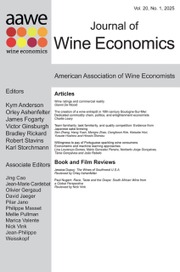
Unlocking Export Potential:
How Pricing Strategies Boost Hungarian Wine Exports
Gergely Csurilla, Zoltán Bakucs, Imre Fertő
Recent decades have witnessed considerable attention directed towards the role of international trade in fostering economic growth. However, while broad analyses of global trade dominate discourse, sector-specific insights, particularly from industries vital to local economies, are often overlooked. A timely example comes from Hungary’s wine industry, a market characterized by structural heterogeneity and unique policy dynamics following European Union accession. In our recent study published in the Journal of Wine Economics, we shed light on how firm-level pricing strategies—particularly profit margins or “markups”—influence wineries’ decisions to export and their subsequent success abroad.
The wine sector is inherently fascinating because it not only represents substantial economic value but also embodies deep cultural significance, particularly for nations like Hungary, where viticulture is integral to the national identity. For policymakers and business leaders alike, understanding the drivers behind successful internationalization of wine is thus both economically and culturally imperative. Against this backdrop, our research aimed to explore the intersection of markups and export activities, addressing gaps in empirical evidence specific to emerging European markets like Hungary.
At the heart of our inquiry were several interconnected questions. First, does having higher profit margins significantly increase a winery’s likelihood of entering the international market? Second, how does maintaining a presence in export markets affect wineries’ markups over time—are there genuine financial benefits from learning by exporting? Lastly, are there discernible differences in profitability between wineries that export and those that solely operate domestically?
Using robust, firm-level data collected from approximately 200 Hungarian wineries between 2004 and 2019, our analysis offered clear and compelling insights. Firms with higher initial profit margins showed a markedly greater propensity not only to venture into international markets but also to intensify their export efforts. This supports existing theories suggesting that profitable firms are better equipped financially and strategically to overcome the barriers associated with entering foreign markets.
Moreover, our findings illuminated the powerful feedback loop of “learning by exporting.” Firms entering export markets for the first time demonstrated a significant increase in their profit margins—approximately 17 to 20 percent—once they started exporting. This phenomenon was even more pronounced for wineries that successfully maintained a sustained export presence, highlighting a clear, cumulative benefit from continued engagement in international markets.
But why is this the case? Our analysis suggests that exporting serves as a vital learning mechanism. Wineries that export adapt more quickly to market dynamics, becoming adept at pricing strategically to navigate competitive pressures. Exporting also exposes wineries to different market conditions, consumer preferences, and competitive practices, prompting them to innovate and improve efficiency. Over time, these insights translate into enhanced profitability, reinforcing their market position domestically and internationally.
Further, when comparing exporting wineries to their domestic-only counterparts, the financial advantage becomes even clearer. Exporters consistently showed profit margins approximately 19 percent higher than non-exporters, a significant differential highlighting the tangible economic benefits of international market engagement. This finding underscores exporting not just as a growth strategy, but as a crucial profitability-enhancing mechanism.
Beyond theoretical implications, these results carry profound practical relevance. For winery managers, our findings underscore the critical importance of strategic pricing as a means to unlock export potential. To successfully enter and thrive in international markets, Hungarian wineries—and similarly structured wineries elsewhere—must prioritize developing and maintaining competitive yet profitable pricing strategies.
From a policy perspective, the message is equally clear. Policymakers looking to bolster local economic growth should consider targeted support to assist wineries in developing robust pricing strategies. This support could take various forms—from direct financial incentives aimed at helping wineries enhance their pricing and branding capabilities, to educational programs designed to improve financial literacy among smaller producers, enhancing their readiness to participate in competitive international markets.
Importantly, our study highlights the unique case of Hungary’s wine industry, where structural fragmentation and recent integration into the European and global markets create conditions distinct from traditionally studied Western European contexts. This contextual specificity makes our findings timely and particularly valuable for emerging European wine producers seeking to carve out a competitive niche internationally.
Moreover, the methodological robustness of our study, employing advanced statistical techniques such as a double hurdle model with instrumental variables to mitigate endogeneity concerns, adds significant credibility and clarity to the insights derived. By carefully disentangling the effects of profitability and productivity from export decisions, our analysis offers nuanced understandings essential for both scholars and industry practitioners.
Reflecting personally on the research journey, what struck us profoundly was the evident strategic imperative underlying successful international market penetration. While efficiency and quality are undeniably vital, strategic pricing emerges as a pivotal lever, often underestimated in policy and management circles. This realization offers a compelling narrative for industry leaders and policymakers alike: strategic market engagement is not merely advantageous—it’s essential.
As we contemplate future research directions, exploring comparative analyses with wine industries in other regions or similar emerging sectors could further enrich our understanding of these dynamics. How universal are the findings from the Hungarian context? Do similar pricing and export patterns emerge in other fragmented, culturally-rich agricultural sectors? Addressing these questions can deepen our understanding of sector-specific export dynamics across diverse economic landscapes.
Ultimately, our study contributes to a broader dialogue about international trade by spotlighting the strategic nuances that define successful export activities in culturally significant industries. By doing so, it not only provides a pathway for Hungarian wineries to increase their international presence and profitability but also serves as a model for similar industries globally, where strategic pricing can unlock export potential, drive economic growth, and reinforce cultural heritage.
For practitioners, scholars, and policymakers alike, our research offers both an evidence-based framework and practical recommendations to harness strategic pricing effectively, affirming the indispensable role of pricing strategies in navigating and thriving in today’s competitive global markets.
Csurilla, G., Bakucs, Z., & Fertő, I. (2025). Wine, markups, and export behavior: Evidence from Hungary. Journal of Wine Economics, 1-13.
https://doi.org/10.1017/jwe.2025.7



